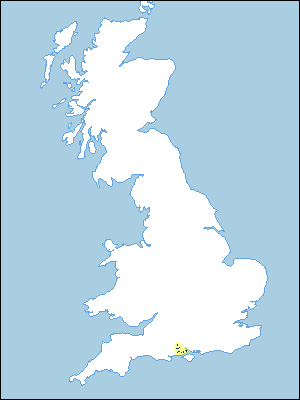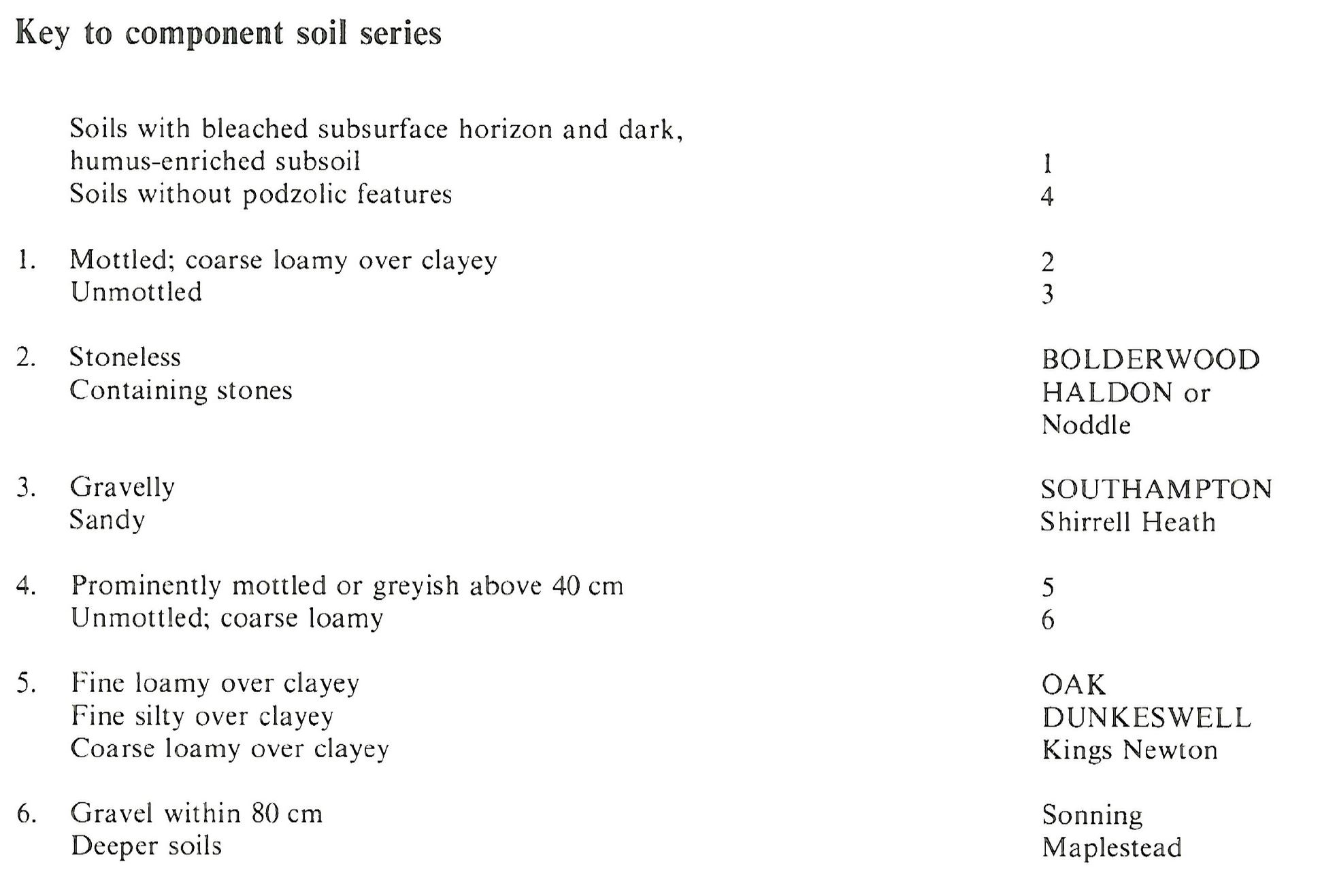
Soil Associations
0643c Bolderwood
Soil and site characteristics
Naturally very acid coarse loamy over clayey soils with a bleached subsurface horizon, slowly permeable subsoils and slight seasonal waterlogging. Humose or peaty surface horizons locally. Some shallow and very flinty soils.
Geology
Plateau gravel and river terrace drift
Cropping and Land Use
Lowland heath habitats and deciduous woodland; recreation; gravel extraction.
Component soil series
| Subgroup | Series name | Percentage | WRB 2006 link |
|---|---|---|---|
| 6.43 | BOLDERWOOD | 35% | Ruptic Stagnic Albic Podzols |
| 6.43 | HALDON | 20% | Ruptic Endostagnic Albic Podzols |
| 6.34 | SOUTHAMPTON | 15% | Episkeletic Ruptic Umbric Albic Podzols |
| 7.14 | OAK | 10% | Chromic Luvic Stagnosols |
| 7.14 | DUNKESWELL | 10% | Chromic Alic Planosols |
Covers 91 km2 in England and Wales
Soilscapes Classification
| 15 |
Naturally wet very acid sandy and loamy soils |
0643c Bolderwood
Detailed Description
The very acid soils of this association occur in the New Forest where river terrace drift and Plateau Gravel cover Tertiary clays, loamy and sands. In the north of the forest, the soils are on a series of flat-topped ridges which descend southward from 125 to 60 m O.D. Further south the association is extensive on level ground at 30-45 m O.D. The sequence of terraces formed by the deposits is related to a former eastward flowing "Solent River". The thickness and character of the river terrace drift and Plateau Gravel varies. On ridges above 50 m O.D. it is flinty, often gravelly, with a sandy, loamy or clayey matrix. A thin, intermittent much less stony loamy or sandy superficial layer occurs locally and widespread distortion of layers indicates periglacial disturbance. On lower ground, flinty drift is covered by stoneless loamy material.
Podzolic soils with slowly permeable subsoil horizons are dominant but variation in texture and stoniness give a narrow range of closely related series. Stoneless coarse loamy over clayey Bolderwood soils, stagnogley-podzols, and similar but stony Haldon soils are most common. Better drained very acid Southampton soils, paleo-argillic podzols, are developed in sandy gravels, and in places where the drift is less stony, fine loamy or fine silty over clayey Oak and Dunkeswell series, paleo-argillic stagnogley soils, with slowly permeable, red mottled subsurface horizons occur.
The principal soils on level ground are Bolderwood and Haldon series. On the northern ridges, Haldon are more common than Bolderwood soils; Southampton soils and similar soils with thin ironpans are frequent near the margins of the level ridge tops. Oak and Dunkeswell soils occur sporadically and are most common in the west. Where the less stony superficial drift is thickest small patches of brown Maplestead soils are present and other brown soils of the Sonning series are found in places, usually beneath oak woodland which has never been cleared. Holidays Hill, Shirrell Heath and coarse loamy over clayey Noddle soils are found on ridge slopes with wetter Wickham and Kings Newton soils in some valley heads where Tertiary clays outcrop. A few narrow wet bottomlands with coarse loamy Fordham soils and small areas of peat are included. On land below 50 m O.D., Bolderwood soils are dominant and Haldon, Oak and Dunkeswell much less common. Southampton soils are restricted to the sides of valleys in which Shabbington soils occur. Brown soils, Ludford and Waterstock series, occur in places.
Soil Water Regime
Subsoil pans and other slowly permeable layers impede vertical water movement through Bolderwood, Haldon, Oak and Dunkeswell soils by causing seasonal waterlogging (Wetness Class III or IV). Excess winter rain is absorbed slowly and water commonly ponds on the land surface after heavy rain but there is little run-off. Southampton soils are permeable and well drained (Wetness Class I).
Cropping and Land Use
The proportion of enclosed agricultural land is small and use is limited to grass paddocks for horses and cattle. Most of the land is open forest grazed by horses, cattle and pigs with heath vegetation dominated by ling (Calluna vulgaris). Investigation of buried profiles and pollen analysis has shown that the development of podzols was in part related to woodland clearance for agriculture, probably in the Bronze Age, and the subsequent invasion of cleared and impoverished land by heath.
Humid heathland with cross-leaved heath (Erica tetralix) and purple moor-grass (Molinia caerulea) is the most widespread plant community. In wet places, sundews (Drosera spp), deer-grass (Trichophorum cespitosum) and bog mosses (Sphagnum spp) occur. Dry heathland with bell-heather (Erica cinerea), dwarf furze (Ulex minor) and bristle agrostis (Agrostis curtisii) is developed on well drained Southampton soils. Grassland communities reflect grazing or past disturbance. Three types can be identified: small areas of heavily grazed lawn along road verges and around ponds dominated by common bent-grass (Agrostis capillaris) and sheep's fescue (Festuca ovina); re-seeded grassland that was ploughed, fertilized and limed in the 1940s and used as wartime airfields, but now includes common bent-grass, sheep's fescue, some white clover (Trifolium repens), Yorkshire fog (Holcus lanatus) and crested dog's-tail (Cynosurus cristatus); and small areas of acid grassland with purple moor-grass and bristle agrostis.
Deciduous woodlands are limited and consist principally of oak or oak and beech with an understorey of holly; the ground flora is often sparse in the unenclosed woods because of continuous grazing but elsewhere bramble (Rubus spp), bracken (Pteridium aquilinum), ivy (Hedera helix), honeysuckle (Lonicera periclymenum) and Holcus spp. are common. There is a little planted woodland which includes some good stands of Douglas fir and pines. Before trees are planted, compact gravel and subsoil pans should be loosened and broken by tine cultivation; phosphorus fertilizer is needed for good establishment. No drainage is necessary but there is a slight risk of windthrow to established trees on exposed ridge tops.
There is widespread soil disturbance through shallow gravel extraction, digging of ponds for watering stock and turf cutting, as well as grading for airfield construction. Some gravel remains but most of the land now forms a well-used recreational resource. The soils have limitations for recreation however: surfaces are wet and muddy in winter and the humose or peaty topsoils are slippery and vulnerable to erosion where heavily trafficked especially by horses. Paths and car parks need drainage and surface reinforcement if undue damage is to be avoided.
0643c Bolderwood
Distribution Map
 |
Note that the yellow shading represents a buffer to highlight the location of very small areas of the association.
Keys to component soil series
South Eastern Region
 |
Typical Landscapes
South Eastern Region
 |
All information Copyright, Cranfield University © 2025
Citation: To use information from this web resource in your work, please cite this as follows:
Cranfield University 2025. The Soils Guide. Available: www.landis.org.uk. Cranfield University, UK. Last accessed 25/04/2025
